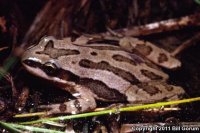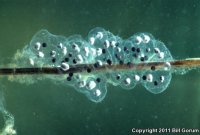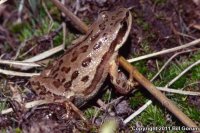| Range: |
 |
| Other Names: |
|
| Description: |
The Boreal Chorus Frog is a small, smooth skinned treefrog. Color varies from green-gray to brown. There is a dark stripe through the eye and a white stripe along the upper lip. It is distinguished from most other treefrogs by the three dark stripes down the back. In some individuals the stripes are broken into dashes or dots. Maximum adult size is just under 4 cm. |
| Similar Species: |
The Boreal Chorus Frog is almost identical to the Western Chorus Frog. It has shorter hind legs but is best distinguished by its call or location. |
| Habitat: |
The preferred habitat for the Boreal Chorus Frog is forest openings around woodland ponds. They will breed in almost any fishless pond with at least 10 cm of water, including splash pools, roadside ditches, flooded fields, beaver ponds, marshes, swamps or shallow lakes. |
| Behavior: |
Very weary of people, easy to hear, tough to find. The breeding call is very similar to the Western Chorus Frog, but is longer and slower in pulse rate. It resembles the sound of drawing your finger down the teeth of a comb. |
| Hibernation: |
Chorus Frogs hibernate beneath logs or underground and are freeze tolerant. |
| Reproduction: |
Boreal Chorus Frogs breed very early in the spring and will call during the day as well as at night. A series of small egg masses are laid and attached to vegetation. Eggs hatch within a few weeks and tadpoles finish transforming by early to mid-summer. They may take one to two years to reach maturity and rarely live beyond three years. |
| Diet: |
They feed on small insects and other invertebrates and are eaten by a wide variety of predators. |













